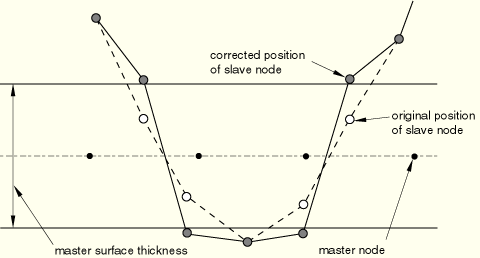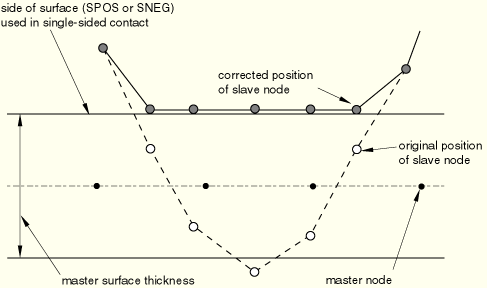
Products: ABAQUS/Explicit ABAQUS/CAE

Adjustments to the positions of the slave nodes in an ABAQUS/Explicit contact pair:
are performed for all contact pairs that have slave nodes that are overclosed and that do not have specified initial clearances, except when nodes of a rigid body act as slave nodes;
can eliminate small gaps or penetrations caused by numerical roundoff when a graphical preprocessor such as ABAQUS/CAE is used;
do not create any strains or momentum in the model during the first step of a simulation;
do create strains and momentum in subsequent steps of a simulation;
should not be used to correct gross errors in the mesh design; and
should not be used to resolve initial overclosures involving a slave node that is pinched between two master surfaces.

ABAQUS/Explicit will automatically adjust the positions of surfaces to remove any initial overclosures that exist when a contact pair is defined in the first step of a simulation, except when nodes of a rigid body act as a slave nodes or user subroutine VUINTER is used. The adjustments are made with strain-free initial displacements to the slave nodes on the surfaces. Therefore, when a balanced master-slave contact pair is defined, nodes on both surfaces may be adjusted. This automatic adjustment of surface position is intended to correct only minor mismatches associated with mesh generation.
Some softened contact models have nonzero contact pressure at zero overclosure (see “Contact pressure-overclosure relationships,” Section 22.1.2). For these models some initial, nonequilibrated contact pressure may be present at the beginning of an analysis, as the adjustments are made to satisfy zero overclosure rather than zero contact pressure. Large initial contact pressures may cause excessive distortion of elements near the contact surfaces.
Conflicting adjustments from separate contact pairs will cause incomplete resolution of initial overclosures and will lead to a noisy solution or severe distortion of elements. This can occur when a slave node is pinched between two master surfaces.
Because of the lack of a unique outward direction from double-sided facets, the resolution of large initial penetrations for double-sided surfaces can be difficult. Initial penetration will be detected only when a slave node lies within the thickness of the underlying element, and the initial penetration will be resolved by moving the slave node to the nearest free surface as shown in Figure 21.4.5–1.
Figure 21.4.5–1 Correction of initial overclosure for a contact pair involving two double-sided surfaces.

Figure 21.4.5–2 Correction of initial overclosure for a contact pair involving a single-sided and a double-sided surface.

Having slave nodes trapped on opposite sides of a double-sided master surface will often lead to serious problems, which may not became apparent until later in an analysis. Therefore, a data check analysis (see “Execution procedure for ABAQUS/Standard and ABAQUS/Explicit,” Section 3.2.2) is recommended prior to running a large contact pair analysis so that you can check for warning messages in the status file (.sta) and check for mislocated adjacent slave nodes on opposite sides of the master surface.
The adjustments affect only the nodes on the surfaces. Excessive distortion of neighboring elements may result if this feature is used to correct for gross errors in the initial geometry, causing the analysis to end with an error message.
Nodes on a rigid body can act as slave nodes only for penalty contact pairs. Initial penetrations of slave nodes that are part of a rigid body are not resolved with strain-free corrections; i.e., the slave nodes are not adjusted. These penetrations are likely to cause artificially large contact forces in the first increments of an analysis and should, therefore, be avoided in the mesh definition.

If contact pairs are defined in later steps with initially overclosed surfaces, ABAQUS/Explicit does not take any special actions to gradually resolve these initial penetrations: contact forces will be applied according to whatever contact constraint enforcement method is being used. These contact forces may be very large, causing large accelerations and velocities and possible distortion of elements. Initial penetrations have the potential to cause problems for contact pairs introduced in any step if a VUINTER user subroutine is used; but in that case you control the application of contact forces.
When a balanced master-slave contact pair is used for situations where the initial overclosure adjustments are not very small, non-negligible errors may persist in the adjusted geometry and can lead to a noisy oscillation (or “ringing”) in the contact procedure. This problem can sometimes be mitigated by modifying the contact pair to be a pure master-slave relationship using a weighting factor; see “Contact surface weighting” in “Contact formulation for ABAQUS/Explicit contact pairs,” Section 21.4.4, for details.

You can define initial clearances and contact directions precisely for the nodes on the slave surface when they would not be computed accurately enough from the nodal coordinates; for example, if the initial clearance is very small compared to the coordinate values. Initial clearances and contact directions can be defined only in small-sliding contact analyses (“Contact formulation for ABAQUS/Explicit contact pairs,” Section 21.4.4).
The initial clearance value calculated at every slave node based on the coordinates of the slave node and the master surface is overwritten by the value that you specify. This procedure does not alter the coordinates of the slave nodes.
When the balanced-master slave contact algorithm is invoked for the contact pair, the initial clearance values can be defined on one or both of the surfaces. Initial clearances defined on contact surfaces that act only as master surfaces will be ignored.
You can specify a uniform clearance for a contact pair by identifying the contact pair and the desired initial clearance, ![]() (the value must be positive). No other data are needed.
(the value must be positive). No other data are needed.
| Input File Usage: | *CLEARANCE, CPSET=cpset_name, VALUE= |
| ABAQUS/CAE Usage: | You cannot specify initial clearance values in ABAQUS/CAE. |
Alternatively, you can specify spatially varying clearances for a contact pair by identifying the contact pair and a table of data specifying the clearance at a single node or a set of nodes belonging to the slave surface. Any slave surface node that is not identified will use the clearance that ABAQUS/Explicit calculates from the initial geometry of the surfaces.
| Input File Usage: | *CLEARANCE, CPSET=cpset_name, TABULAR |
| ABAQUS/CAE Usage: | You cannot specify initial clearance values in ABAQUS/CAE. |
ABAQUS/Explicit can read the spatially varying clearances for a contact pair from an external file.
| Input File Usage: | *CLEARANCE, CPSET=cpset_name, TABULAR, INPUT=file_name |
| ABAQUS/CAE Usage: | You cannot specify initial clearance or overclosure values in ABAQUS/CAE. |
Normally ABAQUS/Explicit calculates the surface normal used for the contact calculations from the geometry of the discretized surfaces, using the algorithms described in “Contact formulation for ABAQUS/Explicit contact pairs,” Section 21.4.4. When specifying spatially varying clearances, you can redefine the contact direction that ABAQUS/Explicit uses with each slave node by specifying the components of this vector. The vector must define the global Cartesian components of the outward normal to the master surface.

There are three sources of information on the adjustments of overclosed surfaces: the status (.sta) file, the message (.msg) file, and the output database (.odb) file.
By default, ABAQUS/Explicit writes the nodal adjustments for all the overclosed nodes in the contact pairs defined in a step to the message (.msg) file along with a summary listing of the maximum initial overclosure and the maximum nodal adjustment to the status (.sta) file for the contact pairs defined in the first step of a simulation. You can choose to suppress the information written to the message file and only write the summary information to the status file.
| Input File Usage: | Use the following option to obtain both detailed diagnostic output to the message file and summary diagnostic output to the status file: |
*DIAGNOSTICS, CONTACT INITIAL OVERCLOSURE=DETAIL (default) Use the following option to obtain only summary diagnostic output to the status file (no contact diagnostics will be written to the message file): *DIAGNOSTICS, CONTACT INITIAL OVERCLOSURE=SUMMARY |
| ABAQUS/CAE Usage: | Detailed diagnostic output requests for contact initial overclosures are not supported in ABAQUS/CAE. |
In the first step the adjustments of initially overclosed surfaces can be viewed in ABAQUS/CAE. Displaced shape plots that show the adjustments to the contact pairs defined in the first step can be plotted for the original field output frame at zero time. Vector plots of nodal displacements and accelerations, in the case of overclosures in steps other than the first, can be particularly helpful in visualizing the adjustments. Such plots can be viewed in ABAQUS/CAE after a data check analysis (see “Execution procedure for ABAQUS/Standard and ABAQUS/Explicit,” Section 3.2.2).
ABAQUS/Explicit does not adjust the coordinates of the slave surface when precise initial clearances are specified for small-sliding contact pairs. Therefore, the specified clearances cannot be seen in a postprocessor such as the Visualization module of ABAQUS/CAE. Thus, depending on the initial geometry of the surfaces and the magnitude of the clearances or overclosures, the surfaces may appear open or closed in the postprocessor when they are actually just in contact in the simulation.